The Featured Creatures collection provides in-depth profiles of insects, nematodes, arachnids and other organisms relevant to Florida. These profiles are intended for the use of interested laypersons with some knowledge of biology as well as academic audiences.
Introduction
The marsh rams-horn, Helisoma (Planorbella) trivolvis (Say), is a species of air-breathing freshwater aquatic snail that is native to Florida. It belongs to the family Planorbidae, commonly known as the ramshorn snail, which comes from the shape of its shell.
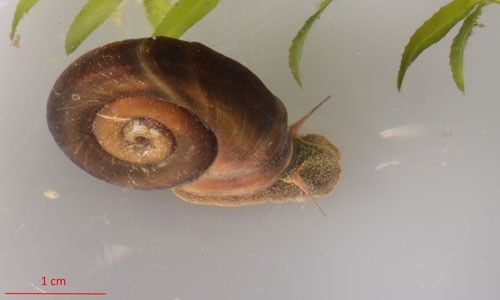
Credit: Lyle J. Buss, UF/IFAS
Synonyms
Planorbella trivolvis intertexta (Sowerby 1878)
Planorbella trivolvis (Say 1817)
Planorbis trivolvis (Say 1817)
Distribution
The marsh rams-horn is native to North America, with its habitat ranging from northern arctic Canada and Alaska to Florida. This species has also been discovered in parts of Mexico, Peru and Ecuador. This species of snail is often seen breathing air or grazing on plants on or near the surface of the water (Baker 1945). The marsh rams-horn can also be found in the bottom of swamps, lakes, rivers, and ponds.
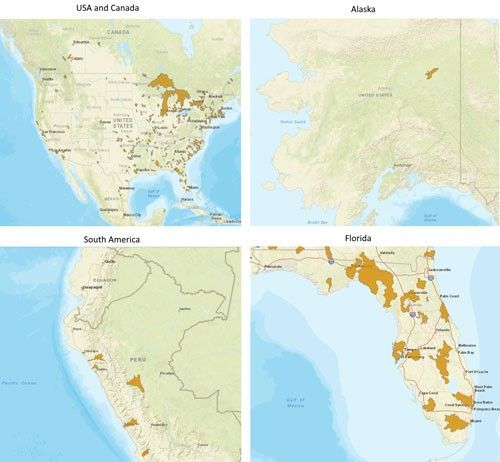
Credit: Distribution data used with permission from The IUCN Red List of Threatened Species
Description
The marsh rams-horn is characterized by its sinistral (left-turning) flat coil shell. The color of the shell ranges from light to dark brown with the body of the snail similar in color. The visible portion of the body of the snail consists of a head, a foot and a pair of tentacles. The snail uses its singular foot for movement via muscle contraction. This foot also allows the snail to walk underneath the surface of the water via surface tension and viscous drag.
The head of the snail contains the mouth and a pair of tentacles with eyes at their base. The mouth is a triangular structure located at the bottom of the head. Inside the mouth is the radula which allows the snail to graze on food via a ribbon structure of tiny teeth (Baker 1945). The snail uses its tentacles to gather chemical cues about its surroundings. Adults reach a maximum size of approximately 15–18 mm (0.6–0.7 in) in shell diameter, with the body being a similar length. The young of this species hatch as crawl-away juveniles, with a strikingly flat-topped shell bearing little resemblance to that of the adult.
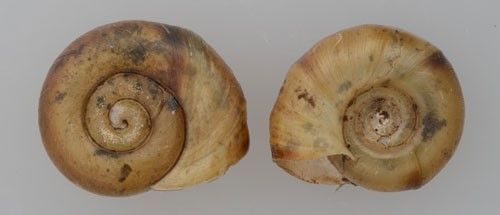
Credit: Lyle J. Buss, UF/IFAS
Life History
Members of this species are hermaphrodites, containing both male and female reproductive organs. This snail is capable of both sexual and asexual reproduction (Burch 1989). The eggs of the marsh rams-horn are contained in a hard, gel-like egg sack that is less than 5 mm (0.2 in). The egg sacs are initially a clear light orange and darken as the eggs mature. The egg sacs can be found stuck on solid surfaces such as aquatic vegetation (Hung et al. 2018). The primary author has observed the marsh rams-horn on bulltongue arrowhead (Sagittaria lancifolia) and pickerelweed (Pontederia cordata). However, the snail is not limited to these two species.
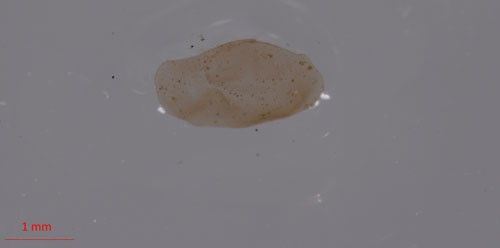
Credit: Lyle J. Buss, UF/IFAS
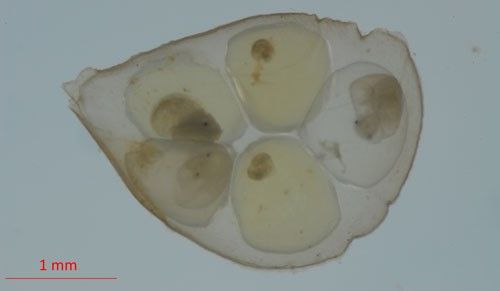
Credit: Lyle J. Buss, UF/IFAS
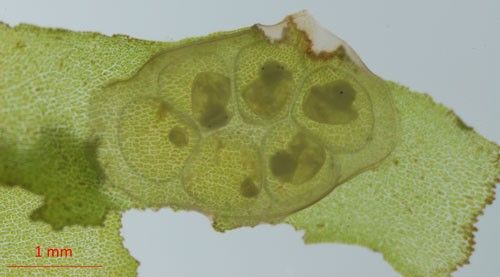
Credit: Lyle J. Buss, UF/IFAS
Hosts
Snails belonging to the family Planorbidae have been known to serve as intermediate hosts for a variety of parasitic trematodes such as Ribeiroia and Schistosoma, both commonly known as flukes. The marsh rams-horn has been observed to be hosts for the larval stage of Echinostoma trivolvis, which are trematodes that can infect humans, fish, and other animals (Fried et al. 1996).
The marsh rams-horn is also a host to another type of parasitic trematode, Ribeiroia ondatrae. This trematode is thought to be responsible for limb malformation in amphibians. This can include either deformed, additional, or missing limbs. Warm temperatures (26°C (78.8°F)) induce the eggs of Ribeiroia to develop up to four times faster. Warming global temperatures can potentially have a major effect on the abundance of this parasite (Paull and Johnson 2011).
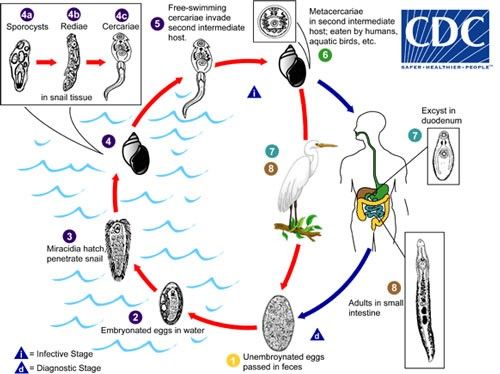
Credit: Image used with permission from the Centers for Disease Control and Prevention
Ecological Significance and Management
Gastropods play a crucial role in nutrient cycling through the grazing of algae and decaying material. The marsh rams-horn is primarily a detritivore, grazing on decaying plants, dead organisms, and algae. In some circumstances they may consume living macrophytic tissues. They also play a role in the aquatic food web by serving as prey for other species such as fish, turtles, birds, and young alligators (Johnson et al. 2018). The marsh rams-horn has been used by researchers as an indicator species for wetland permanence in exurban areas (Urban and Roehm 2018). Exurban areas are the developing rural areas outside of urban areas.
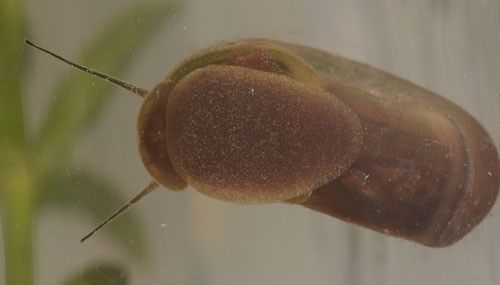
Credit: Lyle J. Buss, UF/IFAS
In some areas marsh rams-horn populations build to levels that have the potential to disrupt fisheries' operations because parasitic trematodes from the snails may infect the fish. In these areas management with perimeter shoreline treatment and aquatic applications have been used to decrease not just marsh rams-horn, but also trematode populations. Treatment options are available for these snails and parasites (Mitchell 2002; Meepagala et al. 2004).
Selected References
Baker FC. 1945. The Molluscan Family Planorbidae. Urbana, Illinois: University of Illinois Press. Pp. 10–11, 17.
Burch JB. 1989. North American Freshwater Snails. Hamburg, Michigan: Malacological Publications. Pp 41–44.
Fried B, Nanni TJ, Reddy A, Fujino T. 1996. "Maintenance of the life cycle of Echinostoma trivolvis (Trematoda) in dexamethasone-treated ICR mice and laboratory-raised Helisoma trivolvis (Gastropoda)." Parasitology Research 83: 16–19.
Hung T, Stevenson T, Sandford M, Ghebremariam T. 2018. "Temperature, density and ammonia effects on growth and fecundity of the ramshorn snail (Helisoma anceps)." Aquaculture Research 49: 1072–1079.
Johnson PD, Bogan AE, Brown KM, Burkhead NM, Cordeiro JR, Garner JT, Hartfield PD, Lepitzki DA, Mackie GL, Pip E, Tarpley TA, Tiemann JS, Whelan NV, Strong EE. 2013. "Conservation status of freshwater gastropods of Canada and the United States." Fisheries 38: 247–282.
Meepagala KM, Sturtz G, Mischke CC, Wise D, Duke SO. 2004. "Molluscicidal activity of vulgarone B against ram's horn snail (Planorbella trivolvis)." Pest Management Science 60: 479–482.
Mitchell AJ. 2002. "A copper sulfate-citric acid pond shoreline treatment to control the rams-horn snail Planorbella trivolvis." North American Journal of Aquaculture 64: 182–187.
Norton CG, Johnson AF, Nelson BM. 2018. "The genetic basis of albinism in the hermaphroditic freshwater snail Planorbella trivolvis." American Malacological Bulletin 36(1): 153–157.
Paull SH, Johnson PTJ. 2011. "High temperature enhances host pathology in a snail-trematode system: Possible consequences of climate change for the emergence of disease." Freshwater Biology 56(4): 767–778.
Sturm CF, Pearce TA, and Valdes A. 2006. The Mollusks: A Guide to Their Study, Collection, and Preservation. Boca Raton, FL: Universal. 257 p.
Urban MC, Roehm R. 2018. "The road to higher permanence and biodiversity in exurban wetlands." Oecologia 186(1): 291–302.